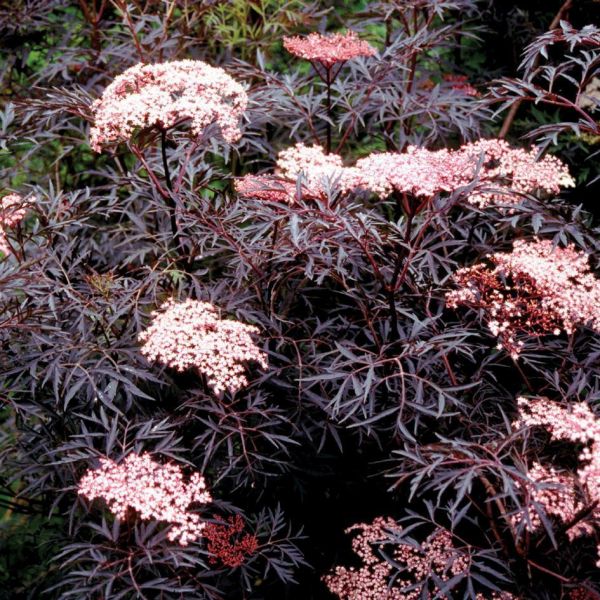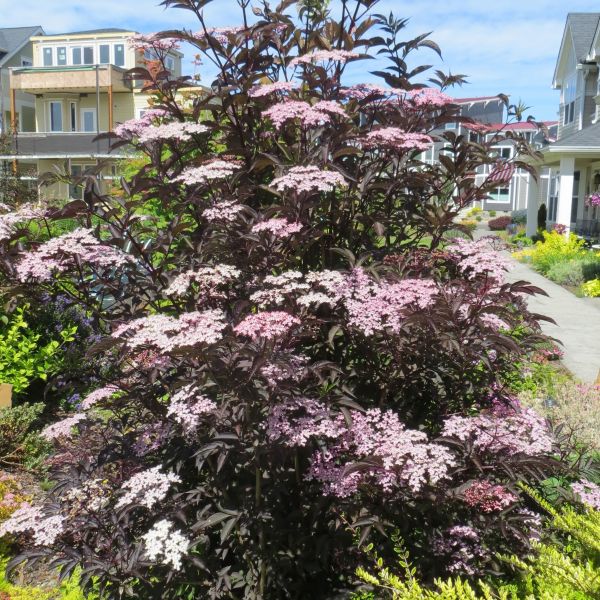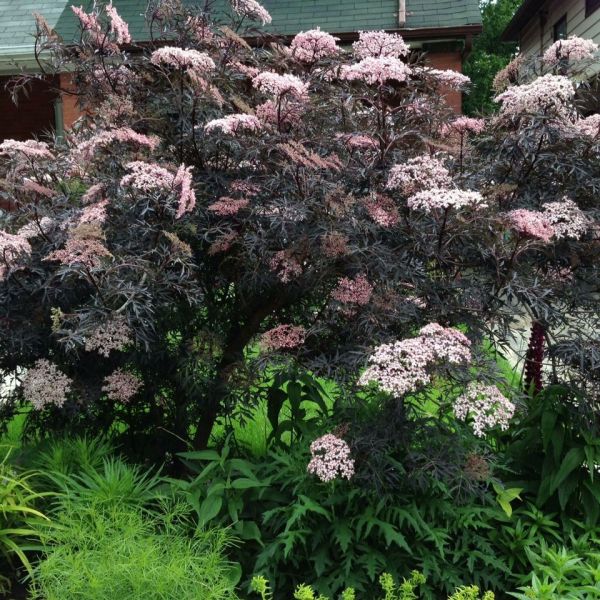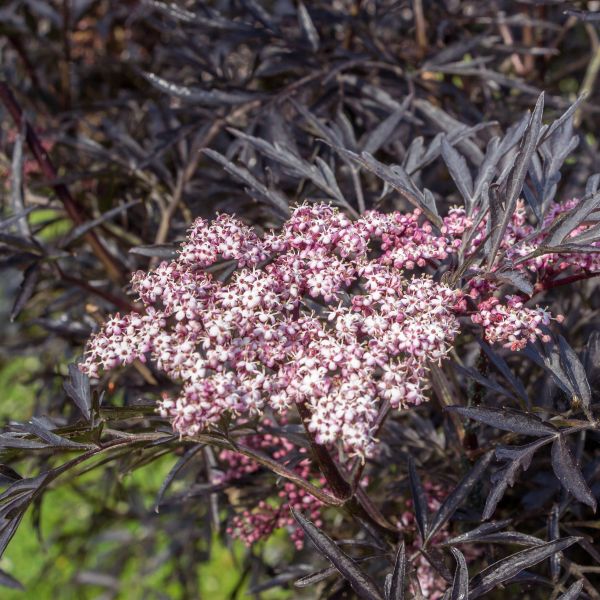




Black Lace Elderberry
Sambucus nigra 'Eva'
88 reviews
Black Lace Elderberry
Sambucus nigra 'Eva'
88 reviews
1 Gallon
We are sorry, product is currently out of stock due to seasonal availability. Please check the "Related plants available in your area" section below
Not just beautiful - intentionally selected by ShrubHub's 3D landscape design team to fit real-world spaces and maximize yard potential.
Why Black Lace Elderberry?
Black Lace Elderberry (Sambucus nigra 'Eva') is a popular deciduous shrub known for its striking dark burgundy foliage and tiny pink flowers that bloom in early summer, followed by dark purple-black berries in the fall. It is a low-maintenance shrub that is easy to grow and adds visual interest to any garden or landscape. Additionally, the berries of this plant can be harvested and used in various culinary dishes and health supplements.
Sunlight
Black Lace Elderberry requires full sun to partial shade. However, it thrives best in full sun conditions, where it can receive at least 6 hours of direct sunlight per day.
Watering
Black Lace Elderberry requires regular watering, especially during dry periods. It prefers consistently moist soil but should not be saturated. Adequate drainage is essential to prevent waterlogging. It is recommended to water deeply and allow the top laye
Fertilizing
Black Lace Elderberry requires a well-drained soil with a pH level between 5.5 and 6.5. It benefits from regular fertilization with a balanced, slow-release fertilizer formulated for woody plants. It is recommended to follow the specific fertilizer manufac
Creamy Pink Flowers & Intense Purple-Black Foliage? Only With the Black Lace Elderberry Bush!
The Black Lace Elderberry is a stunning plant that is a popular choice for its unique appearance, easy maintenance, and numerous health benefits.
Its intense purple-black foliage is deeply cut, creating a lacy texture that is unlike any other plant. The leaves are complemented by clusters of light pink flowers in the spring, which produce blackish-red fall berries in early summer. The plant grows to a height of around six feet, making it the perfect choice for borders, hedges, or as a standalone specimen.
But the Black Lace Elderberry is more than just a pretty face. This plant is packed with health benefits, including its high levels of antioxidants and anti-inflammatory compounds. The berries are also rich in vitamins and minerals, making them a great addition to a healthy diet.
The benefits of the Black Lace Elderberry don't stop there. This plant is incredibly easy to care for, making it an ideal choice for those who want to add some greenery to their outdoor space without spending hours on maintenance. It is resistant to pests and diseases and can tolerate acid or alkaline soils. It is also drought-tolerant, meaning it can survive in areas with limited water supply.
Whether you're looking to create a formal garden, add some structure to your landscape, or simply add some greenery to your outdoor space, the Black Lace Elderberry is the perfect choice.
With its stunning appearance, easy maintenance, and numerous health benefits, it's no wonder why this plant is a favorite among homeowners and landscapers alike. So why wait? Add the Black Lace Elderberry to your garden today and enjoy all the benefits it has to offer!
Plant Information:
| Botanical Name: | Sambucus nigra 'Eva' |
| USDA Zones: | 4 - 7 |
| Water: | Widely Adaptable |
| Exposure: | Full Sun |
| Soil Needs: | Widely Adaptable |
| Mature Height: | 6 - 8 feet |
| Mature Spread: | 6 - 8 feet |





Pollination Info
FAQ
Black Lace Elderberry (Sambucus nigra 'Eva') FAQ:
What is the Black Lace Elderberry and how does it look like?
Black Lace Elderberry (Sambucus nigra 'Eva') is a deciduous shrub that is grown for its unique foliage and attractive berries. The plant has lacy, dark purple-black leaves that are deeply cut, and contrasting pink flowers in the spring that bloom in flat-topped clusters. The plant can grow to be 6-8 feet tall and wide when mature.
How do I care for my Black Lace Elderberry plant?
Here are some tips to care for your Black Lace Elderberry:
- Plant the shrub in full sun to partial shade, and in well-drained soil with a pH range of 5.5 to 6.5.
- Water the plant regularly, especially during dry spells. Avoid overwatering as it can lead to root rot.
- Prune the plant in late winter or early spring to remove any dead or diseased branches, and to maintain the shape of the plant.
- Fertilize the plant in early spring with a balanced fertilizer.
- Protect the plant from pests and diseases by monitoring it regularly and treating promptly.
When does the Black Lace Elderberry bloom?
The Black Lace Elderberry blooms in the spring, usually in May, and produces pink flowers in flat-topped clusters.
What are the benefits of growing Black Lace Elderberry?
Black Lace Elderberry is a versatile and attractive shrub that adds texture, color, and interest to any garden. In addition to its unique foliage and flowers, it produces edible berries that can be used in jams, jellies, and syrups. The plant is also a popular choice for bird-friendly gardens, as the berries are a food source for many bird species.
Is Black Lace Elderberry a poisonous plant?
No, the Black Lace Elderberry is not poisonous. However, the uncooked berries and other parts of the plant contain toxic compounds that can cause vomiting, diarrhea, and other symptoms if ingested in large quantities. It is recommended to cook the berries before consumption.
Can I grow Black Lace Elderberry in a container?
Yes, Black Lace Elderberry can be grown in a container. However, the plant requires a large container to allow for proper root development, and it will need to be watered more frequently than plants grown in the ground. It is also important to ensure that the container has good drainage to prevent waterlogging and root rot.
Planting & Care
Planting & Care for Black Lace Elderberry (Sambucus nigra 'Eva')
Planting:
- Choose a location with full sun to partial shade and well-drained, moist soil.
- Dig a hole twice as wide and as deep as the root ball.
- Place the plant in the hole and fill in the soil, packing it lightly around the plant.
- Water deeply.
- Mulch around the base of the plant to retain moisture and prevent weeds.
Care:
- Water regularly to keep the soil moist, but not waterlogged.
- Fertilize in early spring with a balanced, slow-release fertilizer.
- Prune in late winter or early spring to remove dead or damaged branches, and to shape the plant.
- Watch for pests and diseases, and treat as necessary.
- Harvest the berries in late summer or early fall.
Tips:
- Black Lace Elderberry is a fast-growing plant, and may need to be pruned several times per year to keep it in shape.
- The berries are edible, but must be cooked before eating.
- Pollinators, such as bees and butterflies, are attracted to the plant.
Check Out These Verified Customer Reviews:
Customer Reviews
4.7 out of 5 based on 88 reviews
Thank you! Your review has been submitted.
Thrilled with the Black Lace Elderberry purchase, exceeded my expectations in every way.
Impressed with the appearance of the Black Lace Elderberry plant, looks even better in person.
Highly recommend the Black Lace Elderberry, great addition to any garden or landscape.
Item has been added to your cart.


